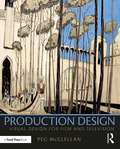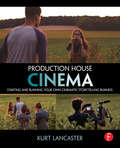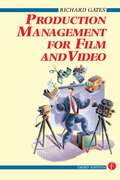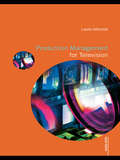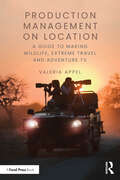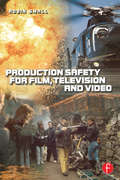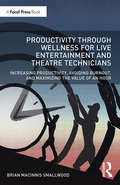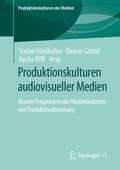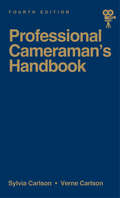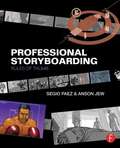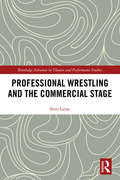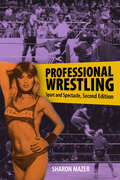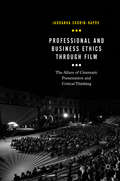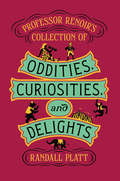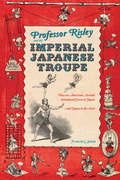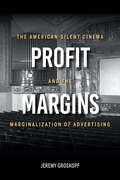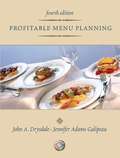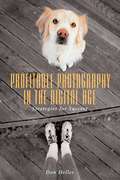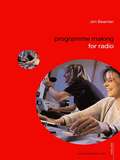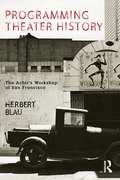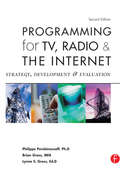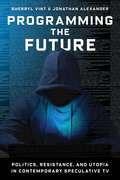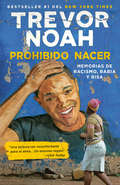- Table View
- List View
Production Design: Visual Design for Film and Television
by Peg McClellanProduction Design: Visual Design for Film and Television is a hands-on guide to the craft of Production Design and Art Direction. Author Peg McClellan gives an insider’s view of the experiences and challenges of working as a Production Designer in film and television. The book covers three major areas, starting with an overview and the basics of job responsibilities, the artistic approach and the background which every Production Designer needs to be familiar with, and progressing to the mechanics of the role with a day-to-day breakdown of the job itself. McClellan takes you through script analysis, team collaborations, the hierarchy of a production, hiring a team, the business elements, locations, studio facilities, handling change, and everything in between. With case studies, insights from successful Production Designers, and inspiration in the form of over 200 colour photos and illustrations from storyboards to sets, this is the ideal book for students seeking a career in production design, and professionals looking to further their design knowledge.
Production House Cinema: Starting and Running Your Own Cinematic Storytelling Business
by Kurt LancasterIn Production House Cinema: Starting and Running Your Own Cinematic Storytelling Business, renowned video storyteller Kurt Lancaster offers both students and professionals a practical guide to starting their own video production company and creating cinematic, client-based video content. Utilizing practical know-how along with in-depth analysis and interviews with successful independent production houses like Stillmotion and Zandrak, Lancaster follows the logistics and inspiration of creating production house cinema from the initial client pitch all the way through financing and distribution. The book includes: An examination of the cinematic and narrative style and how to create it; A discussion of the legal procedures and documents necessary for starting and operating a production house; Advice on crafting a portfolio, reel, and website that both demonstrates your unique style and vision and attracts clients; A guide to the financial business of running an independent production house, including invoicing, accounting, and taxes—and how much you should charge clients; Tips for how to better communicate with clients, and how to develop and shape a client’s story; A breakdown of how to select the right gear and equipment for a shoot, on budget; Cinematic case studies that offer detailed coverage of several short films made for clients.
Production Management for Film and Video
by Richard GatesPacked with step by step information, hints and tips, this book provides all the basic information needed to production manage a film or video from beginning to end - from idea to delivery. Production Management for Film and Video gives all the basic information needed to production manage a film or video from beginning to end - from idea to delivery.Aspiring young film producers, programme makers and students of film or video production will find this an essential source of information, as indeed will anybody wishing to improve their knowledge and skills in the field. One is guided from the script or proposal, right through the various stages of production management to include:· script breakdown· crossplotting· scheduling· budgeting· preparation· the shoot· editing and post-production· deliveryNow in its third edition, Production Management for Film and Video has been further revised to include: · information on health and safety requirements· the need to be aware of computer generated imagery · the effect this kind of programme making has on schedules and budgets. Different kinds of management for different productions are also covered - from features through to documentaries - and advice is offered on how to run a production more effectively. Examples, taken from actual productions, demonstrate the kind of documentation needed to develop, run and control a production. Emphasis is placed on the basic principles of good management that apply to all the different kinds of film that can be produced.Richard Gates is a freelance producer/production manager and has been involved in over 40 productions of different kinds. He also lectures extensively on production and production management techniques.
Production Management for Television (Media Skills)
by Leslie MitchellCompletely up to date with relevant information on digital technology and HD TV, this is the only title to focus specifically on television production management, and presents an easily accessible and authoritative guide to the area. Production Management for Television provides a reliable, factual and theoretical framework for an understanding of production management. It includes a reference directory of agencies and organizations, and addresses and contacts for training. Subjects covered include: • the main responsibilities of the production manager• key skills needed by the production manager• routine procedures• appropriate paperwork and record keeping• health and safety issues• rights management• career structure and development for production managers• useful references and further information. The book is supported by a companion website at www.routledge.com/textbooks/9780415424813.
Production Management on Location: A Guide to Making Wildlife, Extreme Travel and Adventure TV
by Valeria AppelProduction Management on Location is your essential companion for mastering the complexities of international documentary production. Written by an experienced production manager who has spent years on location, this book offers a rare, hands-on look at the realities of producing unscripted documentaries in diverse global settings.From adrenaline-fueled adventures to projects featuring celebrity presenters, this guide demystifies the process of prepping, producing, and managing on-location shoots. Whether you're coordinating a small crew or handling high-profile talent, you'll find step-by-step guidance on pre-production planning, logistical coordination, and managing people under demanding circumstances. Featuring exclusive case studies and interviews with award-winning professionals and presenters, the book brings firsthand insights and practical advice from the field. It also delves into the latest trends in production, including sustainability practices and innovations that are becoming essential to good production management.Packed with actionable strategies and behind-the-scenes know-how, this is perfect for emerging and experienced professionals, documentary filmmakers, and students interested in documentary production.
Production Safety for Film, Television and Video
by Robin SmallCovering all aspects of production safety, this is an invaluable reference guide for the independent programme maker, freelancer, manager, producer, tutor and student filmmaker. Robin Small identifies all the major risks and gives advice on how to control and/or eliminate them. Each hazard section includes useful references to the relevant legislation, documents and licences, as well as addresses of organisations for essential advice and recommended further reading. An appendix lists samples of vital certificates, with visual references provided on www.focalpress.com. Important information about hazard identification, risk assessment and safety policy is provided in the chapters covering legislation, health and safety management, personal protective equipment and insurance. Particular hazards are then split into individual sections for ease of reference. These hazards include:AsbestosCranesExplosives and pyrotechnicsFood and cateringManual handing and liftingVisual display screensWorking at heightsThe appendices provide comprehensive contact information for UK and European Heath and Safety sources. They also include sample forms to draw up your own safety system.Robin Small is Senior Lecturer in Television, Media Department at the University of Huddersfield.
Productivity Through Wellness for Live Entertainment and Theatre Technicians: Increasing Productivity, Avoiding Burnout, and Maximizing the Value of An Hour
by Brian MacInnis SmallwoodProductivity Through Wellness for Live Entertainment and Theatre Technicians provides the tools for individuals and organizations to achieve a healthy work–life balance and increase productivity in the production process of live entertainment. Through examination of the limits of the human body, the fundamentals of motivation, and best practices of project management, the reader will develop operational mindfulness and look at new ways to achieve work–life balance. The book explores case studies that show how organizations are promoting work–life balance and reaping the benefits of increased productivity, makes recommendations to reduce burnout and increase productivity among technicians, and discusses how to deal with the various phases of production. An excellent resource for live entertainment technicians, production managers, technical directors, arts managers, managers in live entertainment, and students in Technical Direction and Production Management courses, Productivity Through Wellness for Live Entertainment and Theatre Technicians offers practical solutions to improve the quality of life of employees, reduce the burnout and injuries of overwork, and maximize the value of an hour.
Produktionskulturen audiovisueller Medien: Neuere Perspektiven der Medienindustrie- und Produktionsforschung (Produktionskulturen der Medien)
by Stefan Udelhofen Dennis Göttel Aycha RiffiAls eine der wenigen, deutschsprachigen Überblicksdarstellungen zum interdisziplinären Feld der Production Studies bzw. der Cultural Studies of Media Industries, versammelt der Band aktuelle Beiträge der sozial- und kulturwissenschaftlichen Erforschung von audiovisuellen Medienindustrien in Geschichte und Gegenwart. Neben der Präsentation neuer Erkenntnisse liegt der Schwerpunkt der Beiträge insbesondere auf der theoretischen, methodischen und forschungspraktischen Reflexion, um eine weitergehende Verankerung dieses Forschungsfeldes im deutschsprachigen Raum voranzutreiben.
Professing Performance
by Shannon JacksonToday's academic discourse is filled with the word 'perform'. Nestled amongst a variety of prefixes and suffixes (re-, post-, -ance, -ivity?), the term functions as a vehicle for a host of contemporary inquiries. For students, artists, and scholars of performance and theatre, this development is intriguing and complex. By examining the history of theatre studies and related institutions and by comparing the very different disciplinary interpretations and developments that led to this engagement, Professing Performance offers ways of placing performance theory and performance studies in context. This 2004 book considers the connection amongst a range of performance forms such as oratory, theatre, dance, and performance art and explores performance as both a humanistic and technical field of education. Throughout, she explores the institutional history of performance in the US academy in order to revise current debates around the role of the arts and humanities in higher education.
Professional Cameraman's Handbook, The
by Sylvia E Carlson Verne CarlsonThis new edition of an all-time best-seller is completely revised and updated and details the components and step-by-step use of over forty of the most widely used film cameras. Significant new topics include time code and time code slates, video assist, and the Steadicam film stabilizing system. Among a few of the new camera systems are the Aaton 16mm; Arriflex 535, 35-3, 35-BL3 and -BL4, and 16BL; Fries 35R3; and the all new Panavision Panaflex 35mm and 16mm. The book teaches basic film camera procedures and troubleshooting techniques. It also looks at all the components, accessories (including lenses), and support systems.
Professional Idiot: A Memoir
by Stephen Glover David Peisner"It's mind-blowing to me how utterly far gone Steve-O was, and how he looks back on it in this book with such intelligence, humor, and searing honesty. What a truly unbelievable life."--Johnny KnoxvilleFrom his early days videotaping crazy skateboard stunts to starring in the Jackass movies, there was little that Stephen "Steve-O" Glover wouldn't do. Whether it was stapling his nutsack to his leg or diving into a pool full of elephant crap, almost nothing was out of bounds. As the stunts got crazier, his life kept pace. He developed a crippling addiction to drugs and alcohol, and an obsession with his own celebrity that proved nearly as dangerous. Only an intervention and a visit to a psychiatric ward saved his life. Today he has been clean and sober for more than three years.Professional Idiot recounts the lunacy, the debauchery, the stunts, the drug addiction, and the path to recovery with bravado, humor, and heart."A great book to read before you get on the roller coaster to hell, if you plan on surviving to tell about it like Steve-O did."--Nikki Sixx, author of The Heroin Diaries"This is the perfect book for people who hate reading."--Tommy Lee, author of TommylandThe feedback I've gotten on Facebook and Twitter from those of you who've read this book has been fascinating, heartwarming, and hilarious. I'm happy to keep answering your questions on there, and I encourage more of you to join in the discussion. Hope to hear from you soon, and thank you all so much.Love,Steve-O
Professional Storyboarding: Rules of Thumb
by Sergio Paez Anson JewStoryboarding is a very tough business, and many, if not most board artists struggle to make a decent living. A new storyboarder really needs to have their wits about them and have some professional savvy to survive in this very tough, competitive field. Storyboarding: Rules of Thumb offers highly illustrative examples of basic storyboarding concepts, as well as sound, career-oriented advice for the new artist. This book also features a number of veteran storyboard artists sharing their experiences in the professional world. <P><P>Includes exercises, case studies, and interviews with leading professionals - grounded with practical advice and experienced step-by-step workflows. <P><P>Great for beginner to intermediate storyboard artists; explore the basic principles of storyboarding including design, composition and color as well as panel to panel storytelling and page to page storytelling. <P><P>Breaks down what new professionals can expect on the business-side of the artform - from an experienced professional artist.
Professional Wrestling and the Commercial Stage (Routledge Advances in Theatre & Performance Studies)
by Eero LaineProfessional Wrestling and the Commercial Stage examines professional wrestling as a century-old, theatrical form that spans from its local places of performance to circulate as a popular, global product. Professional wrestling has all the trappings of sport, but is, at its core, a theatrical event. This book acknowledges that professional wrestling shares many theatrical elements such as plot, character, scenic design, props, and spectacle. By assessing professional wrestling as a neglected but prototypical case study in the global business of theatre, Laine argues that it is an exemplary form of globalizing, commercial theatre. He asks what theatre scholars might learn from pro wrestling and how pro wrestling might contribute to conversations beyond the ring, by considering the laboring bodies of the wrestlers, and analyzing wrestling’s form and content. Of interest to scholars and students of theatre and performance, cultural studies, and sports studies, Professional Wrestling and the Commercial Stage delimits the edges of wrestling’s theatrical frame, critiques established understandings of corporate theatre, and offers key wrestling concepts as models for future study in other fields.
Professional Wrestling: Sport and Spectacle, Second Edition (Performance Studies Series)
by Sharon MazerProfessional wrestling is one of the most popular performance practices in the United States and around the world, drawing millions of spectators to live events and televised broadcasts. The displays of violence, simulated and actual, may be the obvious appeal, but that is just the beginning. Fans debate performance choices with as much energy as they argue about their favorite wrestlers. The ongoing scenarios and presentations of manly and not-so-manly characters—from the flamboyantly feminine to the hypermasculine—simultaneously celebrate and critique, parody and affirm the American dream and the masculine ideal. Sharon Mazer looks at the world of professional wrestling from a fan’s-eye-view high in the stands and from ringside in the wrestlers’ gym. She investigates how performances are constructed and sold to spectators, both on a local level and in the “big leagues” of the WWF/E. She shares a close-up view of a group of wrestlers as they work out, get their faces pushed to the mat as part of their initiation into the fraternity of the ring, and dream of stardom. In later chapters, Mazer explores professional wrestling’s carnivalesque presentation of masculinities ranging from the cute to the brute, as well as the way in which the performances of women wrestlers often enter into the realm of pornographic. Finally, she explores the question of the “real” and the “fake” as the fans themselves confront it. First published in 1998, this new edition of Professional Wrestling: Sport and Spectacle both preserves the original’s snapshot of the wrestling scene of the 1980s and 1990s and features an up-to-date perspective on the current state of play.
Professional and Business Ethics Through Film: The Allure Of Cinematic Presentation And Critical Thinking (Palgrave Studies In Business, Arts And Humanities Ser.)
by Jadranka Skorin-KapovThis book considers ethical issues arising in professional and business settings and the role of individuals making decisions and coping with moral dilemmas. Readers can benefit from engagement in filmic narratives, as a simulated environment for developing a stance towards ethical challenges. The book starts by elaborating on critical thinking and on normative ethical theories, subsequently presenting the structure and cinematic elements of narrative film. These two avenues are tools for evaluating films and for discussions on various ethical problems in contemporary business, including: the corporate and banking financial machinations (greed, fraud, social responsibility); workplace ethical challenges (harassment, violence, inequity, inequality); professional and business ethical challenges (corruption, whistleblowing, outsourcing, downsizing, competition, and innovation); environmental and social issues; international business and human rights; and personal responsibility and identity challenges due to career pressures, loss of privacy and cyber harassment, and job structure changes in light of changing technology.
Professor Renoir's Collection of Oddities, Curiosities, and Delights
by Randall PlattA gripping historical fiction friendship story that will grab everyone by the heartstrings and never let go.A giant, a dwarf, and three doomed circus animals . . .By her fourteenth birthday, Babe Killingsworth measures 6ʹ9ʺ and weighs 342 pounds. In 1896, what other options does a giant have but to join a carnival?Her only real talent is handling animals: “Critters is folks to me.” The cheap outfit her feckless father sells her off to offers critters galore; an escape from Neal, Idaho; and a bit of fame. It also opens the doorway to exploitation and neglect.But Babe’s love for Euclid (a chimp) and Jupiter (a bear) keeps her anchored, and in Professor Renoir’s Collection of Oddities, Curiosities, and Delights, she is among her own kind.Enter Carlotta Jones, billed as the world’s smallest girl, whose elephant act leaves much to be desired. At thirty inches tall, Carlotta is beautiful, spoiled, and demanding and has very little talent—Egypt, her elephant, dances better than she does.How can a giant like Babe and a dwarf like Carlotta ever see eye to eye? They don’t at first, but soon they understand that a common enemy can bring anyone together—even a giant and a dwarf.
Professor Risley and the Imperial Japanese Troupe
by Frederik L. Schodt"Frederik L. Schodt has at long last unveiled the fascinating story of 'Professor Risley.' Circus scholars, history buffs, and anyone with an ounce of curiosity should be grateful to him."--Dominique Jando, Circopedia.org "Professor" Risley (Richard Risley Carlisle) introduced the Western circus to Japan in 1864. Three years later, this former acrobat gave many in the West their first glimpse of Japan when he took his "Imperial Japanese Troupe" of acrobats and jugglers on a triumphant tour of North America and Europe. Over the next few years, the Troupe performed before presidents, monarchs, and ordinary citizens. Frederik L. Schodt argues compellingly that such early popular entertainments helped stir a curiosity about all things Japanese that eventually led to japonisme, The Mikado, and, in our time, the boom in manga and anime. Schodt's depiction of Risley and his troupe is enlivened by portraits of the circus demimonde and supported by nineteenth-century photographs, posters, and drawings, many in color. His accounts of these first meetings between Westerners and Japanese shed new light on how different cultures meet, mingle, and influence each other. Descriptions of crowds, dazzling routines, and superstar troupe performers like the famous Little All Right are a delightful revelation to anyone interested in Asia, the circus, and popular entertainment. Frederik L. Schodt has authored numerous books about Japan, including Manga! Manga! and Native American in the Land of the Shogun. In 2009 for his work he was awarded the Order of the Rising Sun, Gold Rays with Rosette.
Profit Margins: The American Silent Cinema and the Marginalization of Advertising
by Jeremy GroskopfBetween the advent of print advertising and the dawn of radio came cinema ads. These ads, aimed at a captive theater audience, became a symbol of the developing binary between upper-class film consumption and more consumerist media.In Profit Margins, Jeremy Groskopf examines how the ad industry jockeyed for direct advertisement space in American motion pictures. In fact, advertisers, who recognized the import of film audiences, fought exhibitors over what audiences expected in a theater outing. Looking back at these debates in four case studies, Groskopf reveals that advertising became a marker of class distinctions in the cinema experience as the film industry pushed out advertisers in order to create a space free of ads. By restricting advertising, especially during the rise of high-class, palatial theaters, the film industry continued its ongoing effort to ascend the cultural hierarchy of the arts. An important read for film studies and the history of marketing, Profit Margins exposes the fascinating truth surrounding the invention of cinema advertising techniques and the resulting rhetoric of class division.
Profitable Menu Planning, Fourth Edition
by John A. Drysdale Jennifer Adams Galipeau<P>This volume offers single-volume coverage of all aspects of menu planning.<P> Hands-on and real-world in approach, it features accompanying interactive software with specific examples of costing, mark-ups and menu engineering.
Profitable Photography in Digital Age: Strategies for Success
by Dan HellerThis groundbreaking resource demonstrates how to use digital imaging and the Internet as the cornerstone of a successful photography business. Topics covered include setting business goals, marketing, setting prices, selling prints, running a Web-based photography business, working with stock agencies, legally protecting images, and more. Both serious amateurs considering a start-up and established businesses looking for fresh approaches need this timely, relevant book.Allworth Press, an imprint of Skyhorse Publishing, publishes a broad range of books on the visual and performing arts, with emphasis on the business of art. Our titles cover subjects such as graphic design, theater, branding, fine art, photography, interior design, writing, acting, film, how to start careers, business and legal forms, business practices, and more. While we don't aspire to publish a New York Times bestseller or a national bestseller, we are deeply committed to quality books that help creative professionals succeed and thrive. We often publish in areas overlooked by other publishers and welcome the author whose expertise can help our audience of readers.
Programme Making for Radio
by Jim BeamanProgramme Making for Radio offers trainee radio broadcasters and their instructors focused practical guidelines to the professional techniques applied to the making of radio shows, explaining how specific radio programmes are made and the conventions and techniques required to produce them. This book describes how and why these methods are applied through the use of a behind-the-scenes glimpse at working practices and procedures used in the industry. It considers the constraints and incentives that limit or stimulate creativity and innovation within programme production. Programme Making for Radio examines the individual roles and responsibilities of the whole production team and the importance of team-working skills. Chapters focus on the specific requirements of specialist programmes and offer advice from a range of programme makers working in local and national broadcasting. There is a case study example that follows the progress of a feature programme from pitching the original idea, through assembling material to final transmission. Programme Making for Radio includes: a clear description of the role of each member of the programme making team, their duties and responsibilities practical tips on interviewing, mixing and presenting explanations of the key elements that make up a radio programme such as clips, wraps, packages, features and interviews with a full glossary of technical terms. This book is informative, accessible and comprehensive, covering the whole range of skills needed by the radio professional in the studio and on location.
Programming Theater History: The Actor's Workshop of San Francisco
by Herbert Blau‘One of the great stories of the American theater..., the Workshop not only built an international reputation with its daring choice of plays and nontraditional productions, it also helped launch a movement of regional, or resident, companies that would change forever how Americans thought about and consumed theater.’ – Elin Diamond, from the Introduction Herbert Blau founded, with Jules Irving, the legendary Actor's Workshop of San Francisco, in 1952, starting with ten people in a loft above a judo academy. Over the course of the next 13 years and its hundred or so productions, it introduced American audiences to plays by Brecht, Beckett, Pinter, Genet, Arden, Fornes, and various unknown others. Most of the productions were accompanied by a stunningly concise and often provocative programme note by Blau. These documents now comprise, within their compelling perspective, a critique of the modern theatre. They vividly reveal what these now canonical works could mean, first time round, and in the context of 1950s and 60s American culture, in the shadow of the Cold War. Programming Theater History curates these notes, with a selection of the Workshop's incrementally artful, alluring programme covers, Blau's recollections, and evocative production photographs, into a narrative of indispensable artefacts and observations. The result is an inspiring testimony by a giant of American performance theory and practice, and a unique reflection of what it is to create theatre history in the present.
Programming for TV, Radio & The Internet: Strategy, Development & Evaluation
by Philippe Perebinossoff Lynne Gross Brian GrossWhere do program ideas come from? How are concepts developed into saleable productions? Who do you talk to about getting a show produced? How do you schedule shows on the lineup? What do you do if a series is in trouble? The answers to these questions, and many more, can be found in this comprehensive, in-depth look at the roles and responsibilities of the electronic media programmer. Topics include: Network relationships with affiliates, the expanded market of syndication, sources of programming for stations and networks, research and its role in programming decisions, fundamental appeals to an audience and what qualities are tied to success, outside forces that influence programming, strategies for launching new programs or saving old ones. Includes real-life examples taken from the authors' experiences, and 250+ illustrations!
Programming the Future: Politics, Resistance, and Utopia in Contemporary Speculative TV
by Professor Sherryl Vint Professor Jonathan AlexanderFrom 9/11 to COVID-19, the twenty-first century looks increasingly dystopian—and so do its television shows. Long-form science fiction narratives take one step further the fears of today: liberal democracy in crisis, growing economic precarity, the threat of terrorism, and omnipresent corporate control. At the same time, many of these shows attempt to visualize alternatives, using dystopian extrapolations to spotlight the possibility of building a better world.Programming the Future examines how recent speculative television takes on the contradictions of the neoliberal order. Sherryl Vint and Jonathan Alexander consider a range of popular SF narratives of the last two decades, including Battlestar Galactica, Watchmen, Colony, The Man in the High Castle, The Expanse, and Mr. Robot. They argue that science fiction television foregrounds governance as part of explaining the novel institutions and norms of its imagined futures. In so doing, SF shows allegorize and critique contemporary social, political, and economic developments, helping audiences resist the naturalization of the status quo. Vint and Alexander also draw on queer theory to explore the representation of family structures and their relationship to larger social structures. Recasting both dystopian and utopian narratives, Programming the Future shows how depictions of alternative-world political struggles speak to urgent real-world issues of identity, belonging, and social and political change.
Prohibido nacer: Memorias De Racismo, Rabia Y Risa
by Trevor NoahMÁS DE UN MILLÓN DE EJEMPLARES VENDIDOS NOMBRADO UNO DE LOS MEJORES LIBROS DEL AÑO POR Michiko Kakutani, New York Times USA Today San Francisco Chronicle NPR Esquire Newsday Booklist La impresionante trayectoria de Trevor Noah, desde su infancia en Sudáfrica durante el apartheid hasta el escritorio de The Daily Show, comenzó con un acto criminal: su nacimiento. Trevor nació de un padre suizo blanco y una madre Xhosa negra, en una época de la historia sudafricana en que tal unión era castigada con cinco años de prisión. Como prueba viviente de la indiscreción de sus padres, Trevor permaneció los primeros años de su vida bajo el estricto resguardo de su madre, quien se veía obligada a tomar medidas extremas y, a veces, absurdas para ocultar a Trevor de un gobierno que podría, en cualquier momento, llevárselo. Prohibido nacer es la historia de un niño travieso que se convierte en un joven inquieto mientras lucha por encontrarse a sí mismo en un mundo enel que nunca se suponía que debía existir. También es la historia de la relación de ese joven con su intrépida, rebelde y ferviente madre religiosa: su compañera de equipo, una mujer decidida a salvar a su hijo del ciclo de pobreza, violencia y abuso que en última instancia amenazaría su propia vida.
